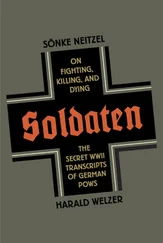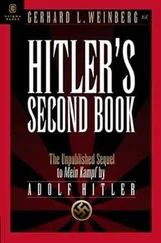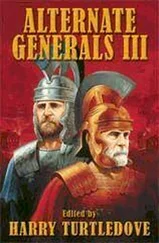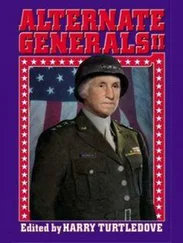In ‘Weltwoche: Unabhängige Schweizerische Umschau 13’, (1945), No. 585, p. 3 (26.1.1945), accompanying an article ‘Kann sich Hitler noch auf die SS verlassen?’ (‘Can Hitler Still Rely on the SS?’), a photograph was published above a caption indicating that it portrayed Polish civilians unearthing mass graves containing the corpses of their murdered countrymen. It shows two SS men, a number of civilians with shovels, and some corpses in civilian clothes. In the article an anonymous SS man speaks of events at Zhitomir in the winter of 1942 in which tens of thousands were murdered and interred in mass graves.
At Lublin-Maidanek death camp approximately 250,000 people were murdered by gassings and mass shootings between October 1941 and July 1944. The only large concentration camp in Czechoslovakia was at Theresienstadt (today Terezin), a ghetto-like complex 60 kilometres north-west of Prague. Between 24.11.1941 and 20.4.1945, 140,000 Jews were brought there from western and central Europe; 33,000 died of starvation and the poor hygiene conditions in the overcrowded camp; 88,000 went to the death camps in the east. ‘Enzyklopädie des Holocaust’, Vol. 3, pp. 1403–7.
General der Artillerie Alfred von Vollard-Bockelberg (18.6.1874 – disappeared 1945), 6.9.1939 Military Cdr, Posen; 26.10.1939 C-in-C, Border Region Centre; 5.11.1939–14.5.1940 CO, Wehrkreis I, Königsberg. At this time Rothkirch was Ia, XXXIV.Armeekorps stationed in the General-Gouvernement and probably met Vollard-Bockelberg in October 1939.
Between 25.12.1942 and 10.6.1943, Wilhelm Daser was CO, Oberfeldkommandantur 670 at Lille, one of nine districts under the Military Cdr, Belgium and Northern France, General Alexander von Falkenhausen. Between 27.11.1942 and 10.7.1944, Falkenhausen had 240 hostages shot in 18 separate incidents; 30 persons were shot during Daser’s period in office, 10 of whom were executed in Brussels on 16.1.1943 for attacks on Wehrmacht personnel in Oberfeldkommandantur 670 district. Daser authorised the seizure of hostages as a reaction to the attacks, but the death sentences were handed down by Falkenhausen. Weber, ‘Die innere Sicherheit’, esp. p. 139ff; Warmbrunn, ‘Occupation of Belgium’.
Wildermuth refers here to the massacre at Kralievo in the nine days from 15.10.1941, in which 4,000 to 5,000 civilians were shot dead as a reprisal by units of 717.Inf.Div. After the town was attacked by Chetniks on 5.10.1941, the Dornier aircraft factory was closed the following day for the alleged unreliability of the workforce. These employees were then held in a workshop of railway coachmakers together with workshop and railroad staff. On 11.10.1941 the Chetniks launched a second attack on Kralievo that lasted until 16.10.1941. The attacks had had artillery support while Wehrmacht troops came under fire from the civilian population. On 15 and 16.10.1941 between 300 and 1,755 hostages were shot, including the Dornier employees. That a German factory supervisor was shot as a hostage is not confirmed by the archive. The Kralievo district commandant, Oberleutnant Alfons Matziowicz, had issued an instruction on 15.10.1941 that 100 Serbs were to be shot for every dead German. This was authorised under Keitel’s order of 16.9.1941 that the death of a German was to be expiated by the killing of 50 to 100 Serbs; OKW War Diary, Vol. 1, p. 1068. There is scarcely any evidence of Wildermuth’s involvement in the shootings. The 717.Inf.Div. files do not indicate when and on whose orders any particular batch of hostages were shot, although most were carried out by elements of Inf.Reg.749 under Major Desch, senior officer at Kralievo. This unit was guilty of other massacres in the Kralievo area after 16.10.1941. The activity report of Wildermuth’s Inf.Reg.737 for September 1941 does prove, however, that atrocities were committed in his direct area of jurisdiction before the October incident. The report states, ‘140 to 150 enemy dead, 6 wounded, 92 prisoners, 32 prisoners shot , 98 houses, 8 dwellings, 2 villages set alight and destroyed. 39 own forces killed, 47 wounded.’ BA/MA RH26-117/3. The Commdg Gen. Serbia, Franz Böhme (15.4.1885–29.5.1947) expressed harsh criticism at the unleashing of reprisals. ‘The shooting of our agents, Croats and the workforce of German armaments factories are errors that cannot be made good.’ Plenipotentiary Commdg Gen. Serbia, Chief Mil. V./QuNo 3208/41. 25.10.1941 BA/MA RH26/342-14. In Wildermuth’s comprehensive fund of documents the only mention of hostages being shot is a diary entry for 18.10.1941, ‘Kralievo has become a dead city. The viciousness of our reprisals was fearsome’, BA/MA NL251-100. His biographer does not speak of the events at Kralievo. Kohlhaas, ‘Eberhard Wildermuth’, p. 99f. See also Manoschek, ‘Serbien ist judenfrei’, pp. 155–8. A concise arrangement of the crimes in the context of the partisan war appears in Schmider, ‘Auf Umwegen zum Vernichtungskrieg?’.
In World War I, 48 German soldiers were executed for desertion, cowardice, etc. The British executed 291 of their own soldiers, To these must be added the executions of more than 750 Italian, 18 Belgian and 35 US soldiers (between April 1917 and June 1919). In France the courts martial handed down 2,400 death sentences to Army personnel of which about 500 were carried out. Beckett, ‘The Great War’, p. 227f; Bach, ‘Fusillés pour l’exemple’.
The protest of General der Artillerie Paul Bader (20.7.1883–28.2.1971), Cmmdg Gen. of Higher Command LXV, Belgrade cannot be found in the archives.
On 18.10.1942 Hitler ordered that all commandos were to be executed without exception even if they wore uniform. This was as a reprisal for the British commando raid on the Channel Island of Sark on 4.10.1942 when German prisoners had been bound in such a way that they strangled themselves if they attempted to struggle free. No pardons were to be allowed. Individual commandos were to be handed over to the SD. The Order was first enforced on 11.12.1942 when two ‘Cockleshell Heroes’, members of an SBS canoe operation to attack shipping at Bordeaux, were executed. The original of the Order is at BA/MA RW41/v.606. For the application of the Order, see Friedrich, ‘Das Gesetz des Krieges’, pp. 295–306; Messerschmitt, ‘Kommandobefehl und Völkerrechtsdenken’.
On 14.6.1944 a force of 243 RAF bombers attacked Le Havre, sinking numerous German warships and destroying large areas of the town and its docks. French casualties at 75 dead and 150 injured were light as the result of the dock area having been evacuated. For the attack see Hümmelchen, ‘Die deutschen Schnellboote’, p. 175f; and Tent, ‘E-boat Alert’, pp. 146–82.
By the end of 1937, 13,260 inmates had been registered at Dachau concentration camp. That year the camp had an average population of 2,535. This figure increased to 5,068 persons in 1938 after the camp was enlarged. That year 18,681 new prisoners passed through its gates. Kimmel, ‘Konzentrationslager Dachau’, p. 371; Drobisch/Wieland, ‘System der Konzentrationslager’, pp. 288, 303.
Commandant of Dachau camp in 1937 was SS-Oberführer Hans Loritz (12.12.1895–13.1.1946).
It is uncertain which person named Hasse is meant here. Possibly Broich was speaking of the later General der Infanterie Wilhelm Hasse (24.11.1895–13.1.1946) who, like Broich, was an Oberstleutnant in 1937. For Josias Erbprinz zu Waldeck und Pyrmont see note 356 356 Josias Erbprinz zu Waldeck-Pyrmont (13.5.1896–30.11.1967), 6.10.1938 to the capitulation HSSPF Fulda-Werra. Sentenced to life imprisonment, Buchenwald trials, 14.8.1947, released 1.12.1950.
below. Thoma, a native of Dachau, also visited Dachau camp before the war. SRXX 1580, 12.2.1943, TNA WO 208/4162.
Читать дальше








![Traudl Junge - Hitler's Last Secretary - A Firsthand Account of Life with Hitler [aka Until the Final Hour]](/books/416681/traudl-junge-hitler-s-last-secretary-a-firsthand-thumb.webp)



